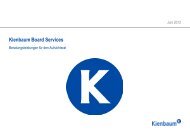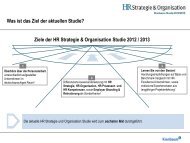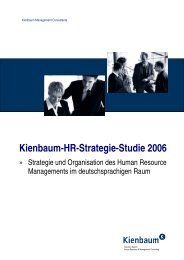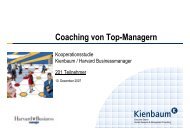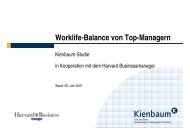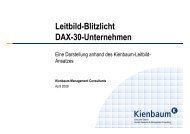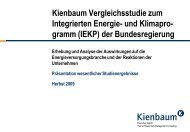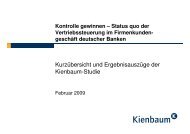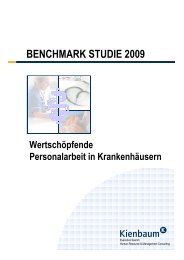Sales & Marketing Excellence - Kienbaum
Sales & Marketing Excellence - Kienbaum
Sales & Marketing Excellence - Kienbaum
You also want an ePaper? Increase the reach of your titles
YUMPU automatically turns print PDFs into web optimized ePapers that Google loves.
Focus on growth<br />
<strong>Sales</strong> Force Effectiveness<br />
<strong>Sales</strong> & <strong>Marketing</strong> <strong>Excellence</strong><br />
The <strong>Sales</strong> & <strong>Marketing</strong> Challenge<br />
Performance Management<br />
“It’s not the strongest of the species that survive, or the most intelligent, but the one most<br />
responsive to change.”<br />
(Charles Darwin)<br />
The number of challenges sales & marketing organizations have had to manage since the end of the 90s<br />
has increased significantly. Globalization opened the door for increased competition from formerly<br />
separated markets, the appearance and growth of competitors, especially from Asia – first from Japan and<br />
later China, India and soon other “tiger” countries – put traditional European and American companies<br />
under pressure. First these tried to “defend” their traditional markets and customers and competed on price<br />
and product quality only. They started cost restructuring programs, but soon it became clear that this<br />
challenge could only be answered by the efforts of the whole value chain, first of all to identify customer<br />
needs and consequently to change its offering in products and service at the right price to the identified<br />
“order winners”.<br />
<strong>Sales</strong> and <strong>Marketing</strong> can often no longer rely on their old and seemingly faithful customer base, but have to<br />
adjust to the increased amount of requirements, needs to work closely with their innovation departments to<br />
develop the right products, “search” for new markets and customer groups, think about segmentation of<br />
markets, customers and products, and then decide on the the right management of customers even on a<br />
global level, the channels they should be approached with, overall embrace change by transforming their<br />
processes, systems, organizations and last but not least the people who drive the former.<br />
The ultimate goal is to drive profitable revenue growth mid and long term. In order to create the required<br />
flexibility <strong>Kienbaum</strong> has developed an approach to achieve the needed transformation and give sales and<br />
marketing organizations the ability to implement further sustainable transformation for future challenges.<br />
1<br />
<strong>Sales</strong> Organisation
<strong>Sales</strong> & <strong>Marketing</strong> <strong>Excellence</strong><br />
<strong>Sales</strong> & <strong>Marketing</strong> Transformation Management – the <strong>Kienbaum</strong> Approach<br />
To achieve sustainable growth of revenue and market share four main Elements need to be evaluated<br />
and adjusted to the “voice of the customer & voice of the market“, finally improved and sustainably<br />
implemented.<br />
Focus on<br />
Growth<br />
<strong>Sales</strong> Force<br />
Effectiveness<br />
World Class<br />
<strong>Sales</strong><br />
Management<br />
SALES SUCCESS<br />
Sustainable revenue growth and<br />
market share<br />
2<br />
Performance<br />
Management<br />
<strong>Sales</strong><br />
Organization<br />
Each of the four elements consists of 5 sub-blocks which in a logical way build on each other and need<br />
to be addressed as a whole to act as enablers for a successful transformation.<br />
Focus on<br />
Growth<br />
Aligned Market Strategy &<br />
<strong>Sales</strong> Objectives<br />
Pricing &<br />
Tendering<br />
“Customer”<br />
Portfolio<br />
"Product"<br />
Portfolio<br />
Voice of the customer /<br />
Voice of the market<br />
<strong>Sales</strong> Force<br />
Effectiveness<br />
Organizational knowledge<br />
Market Position<br />
<strong>Sales</strong><br />
Forecast Planning Process<br />
<strong>Sales</strong> Process<br />
(Customer Contact Time)<br />
Roles & Responsibilities<br />
Client Engagement<br />
Performance<br />
Management<br />
<strong>Sales</strong><br />
Performance Mgmt. System<br />
<strong>Sales</strong><br />
KPI’s<br />
Market Intelligence<br />
<strong>Sales</strong> Incentive &<br />
Compensation Schemes<br />
CRM & IT<br />
Tools<br />
<strong>Sales</strong><br />
Organization<br />
Structural organization<br />
<strong>Sales</strong><br />
Skills<br />
Emotional<br />
Skills<br />
<strong>Sales</strong><br />
Assessment/Audits<br />
<strong>Sales</strong><br />
Training & Development
<strong>Sales</strong> & <strong>Marketing</strong> <strong>Excellence</strong><br />
<strong>Sales</strong> <strong>Excellence</strong> Enablers<br />
<strong>Sales</strong> & <strong>Marketing</strong> Transformation Management – the <strong>Kienbaum</strong> Approach<br />
To achieve transformation and finally sustainable sales & marketing excellence <strong>Kienbaum</strong> suggests<br />
a 4 phase approach to first identify the transformation need and capability of a sales & marketing<br />
organization and second to design required changes and finally implement them.<br />
Focus on<br />
Growth<br />
<strong>Sales</strong> Force<br />
Effectiveness<br />
Performance<br />
Management<br />
<strong>Sales</strong><br />
Organization<br />
Top-Down Support<br />
Pre -<br />
Assessment<br />
Assess Transformation<br />
Need<br />
Customized<br />
Approach<br />
Evaluation<br />
Assess Transformation<br />
Capability<br />
Macro<br />
Concept<br />
3<br />
Design<br />
Conception<br />
Develop Transformation<br />
Capabilities<br />
Bottom-up Involvement<br />
Implementation -<br />
Roadmap<br />
Implementation<br />
Realisation<br />
Deliver <strong>Sales</strong> Progress &<br />
Success<br />
<strong>Kienbaum</strong> has developed an exemplary approach in which order in the 4 phases topics like for<br />
example capturing “Voice of the customer”, “customer portfolio”, “sales skills” and soft<br />
transformation factors like “human capital” are addressed.<br />
Pre-Assessment Evaluation Design & Concept Implementation<br />
Understand<br />
<strong>Sales</strong> Vision & Mission<br />
Interviews / Workshop(s)<br />
with<br />
Key-<strong>Sales</strong>-Players<br />
High level Assessment &<br />
<strong>Sales</strong> Data Analysis<br />
Customized Approach and<br />
Plan for Evaluation Phase<br />
Program Introduction<br />
Kick-Off-Communication<br />
* R&R stands for Roles & Responsibilities<br />
Understand<br />
Aligned Market Strat./<br />
<strong>Sales</strong> Objectives<br />
Understand<br />
Market Position<br />
Analysis<br />
Customer Portfolio<br />
Analysis<br />
Product Portfolio<br />
Analysis<br />
<strong>Sales</strong> Forecast + Planning<br />
Process<br />
Analysis knowledge<br />
of Voice of Customer<br />
(VOC)<br />
Analysis<br />
Pricing & Tendering<br />
Analyze & Design common sales processes, values & behavior involving key sales personnel on every level<br />
Analysis<br />
<strong>Sales</strong> Process<br />
Analysis<br />
<strong>Sales</strong> KPI’s & Personal<br />
Goal Struct.<br />
Analysis<br />
<strong>Sales</strong> Compensation &<br />
Benefits Schemes<br />
Analysis<br />
Informat. Management Process<br />
& IT (e.g. CRM)<br />
Analysis<br />
Market Intelligence &<br />
Information stream<br />
Analysis<br />
R&R, Client Engagement<br />
Analysis<br />
<strong>Sales</strong> Performance<br />
Management System<br />
Analysis<br />
Organizational Structure<br />
Analysis<br />
<strong>Sales</strong> & Emotional<br />
Skills<br />
Analysis<br />
Training & Development<br />
Identified Improvement,<br />
levers & potential<br />
Review 1 st Draft Macro<br />
Concept<br />
Transformation Plan &<br />
Structure<br />
Identified Targets for<br />
Revenue Growth<br />
Macro Concept<br />
Design Micro <strong>Sales</strong><br />
Organization<br />
Design <strong>Sales</strong> Approach /<br />
Process (e.g. KAM)<br />
Design Process capturing<br />
VOC<br />
Design Performance<br />
Management System (incl.<br />
Comp & Ben)<br />
Design Human Capital<br />
Development Plan<br />
Design <strong>Sales</strong> Objectives<br />
Design detailed Comm. &<br />
Transformation Plan<br />
Design concise KPI / Personal<br />
Goal Structure<br />
Implementation<br />
Roadmap<br />
Implementation / Promotion of “new” <strong>Sales</strong><br />
processes, values & behavior<br />
Implementation of Design<br />
Constant Project Status<br />
Control & Management<br />
Sustainability Plan<br />
Possible Executive Search<br />
and Outplacement<br />
Support of Transformation<br />
Process<br />
End of Implementation /<br />
Start Sustainability<br />
Management<br />
Sustainability Management<br />
Sustainability<br />
Management<br />
Supported<br />
by <strong>Kienbaum</strong><br />
as long<br />
as required<br />
or desired
<strong>Sales</strong> & <strong>Marketing</strong> <strong>Excellence</strong><br />
The <strong>Kienbaum</strong> Approach – Pre-Assessment Phase<br />
Pre-Assessment<br />
Understand<br />
<strong>Sales</strong> Vision & Mission<br />
Interviews / Workshop(s) with<br />
Key-<strong>Sales</strong>-Players<br />
High level Assessment & <strong>Sales</strong><br />
Data Analysis<br />
Customized Approach and Plan for<br />
Evaluation Phase<br />
Program Introduction<br />
Kick-Off-Communication<br />
The Pre-Assessment Phase, consists of a “sales vision & mission” workshop and<br />
interviews with prior defined key sales players and a first high level sales & marketing<br />
data analysis. It ensures a common understanding between <strong>Kienbaum</strong> and the<br />
customer’s sales & marketing transformation needs. As a result <strong>Kienbaum</strong> customizes<br />
its exemplary consulting approach to these transformation needs and builds with a<br />
customer team a detailed project plan for the Evaluation Phase containing timelines,<br />
studies (process, data, management audits etc.) project organisation and data<br />
requirements.<br />
The <strong>Kienbaum</strong> Approach – Evaluation Phase<br />
Understand<br />
Aligned Market Strat./<br />
<strong>Sales</strong> Objectives<br />
Understand<br />
Market Position<br />
Analysis<br />
Customer Portfolio<br />
Analysis<br />
Product Portfolio<br />
Analysis<br />
<strong>Sales</strong> Forecast + Planning<br />
Process<br />
Analysis knowledge<br />
of Voice of Customer<br />
(VOC)<br />
Analysis<br />
Pricing & Tendering<br />
Evaluation<br />
Analysis<br />
<strong>Sales</strong> Process<br />
Analysis<br />
<strong>Sales</strong> KPI’s & Personal<br />
Goal Struct.<br />
Analysis<br />
<strong>Sales</strong> Compensation &<br />
Benefits Schemes<br />
Analysis<br />
Informat. Management Process<br />
& IT (e.g. CRM)<br />
Analysis<br />
Market Intelligence &<br />
Information stream<br />
Analysis<br />
R&R, Client Engagement<br />
Analysis<br />
<strong>Sales</strong> Performance<br />
Management System<br />
Analysis<br />
Organizational Structure<br />
Analysis<br />
<strong>Sales</strong> & Emotional<br />
Skills<br />
Analysis<br />
Training & Development<br />
Identified Improvement,<br />
levers & potential<br />
Review 1 st Draft Macro<br />
Concept<br />
Transformation Plan &<br />
Structure<br />
Identified Targets for<br />
Revenue Growth<br />
Macro Concept<br />
The Evaluation Phase assesses the ability of sales &<br />
marketing for the four main elements focus on growth, sales<br />
force effectiveness, performance management and sales<br />
organization.<br />
It has the purpose to understand the transformation<br />
capability for each of these topics, and to build a macro<br />
concept with key levers for improvement to fill existing gaps,<br />
a business case for profitable growth and a to be state<br />
after a transformation programme.<br />
Focus on Growth: Understanding existing sales objectives and alignment with the<br />
existing market & sales strategy. Assessing how the “Voice of the<br />
customer / Voice of the market” has been captured and used (which<br />
channels are used to capture VOC, interviews or questionnaires, what<br />
are the methods to use the gained knowledge eg. conjoint analysis,<br />
battlefield analysis). Assessment and evaluation of the product (abcxyz<br />
analysis as well as life cycle analysis) and customer portfolio<br />
(abc-xyz analysis profit and revenue).<br />
4
<strong>Sales</strong> & <strong>Marketing</strong> <strong>Excellence</strong><br />
The <strong>Kienbaum</strong> Approach – Evaluation Phase<br />
<strong>Sales</strong> Force Effectiveness: Assessment of sales processes, understanding effectiveness (face time with<br />
„Understand<br />
the root cause<br />
why people<br />
act in a<br />
specific way“<br />
„To drive<br />
successful<br />
transformation<br />
and to get<br />
sustainable<br />
results change<br />
the behavior of<br />
your people“<br />
old and new customers) and efficiency (sold units / € per hour face time).<br />
Assessment of Roles & Responsibilities in the process (who does what),<br />
assessment of client engagement approach (lonely hunter or team effort),<br />
assessment of forecasting and planning processes. Real life studies will<br />
be done on the processes to assess gaps and improvement potential (e.g.<br />
Day-in-the-life-of-a-salesman studies which means spend a day with a<br />
salesman or support function to see the problems through the eyes of the<br />
observed party).<br />
<strong>Sales</strong> Performance Assessment of the <strong>Sales</strong> Performance Management System<br />
Management : understanding which sales key performance indicators (leading and lagging<br />
„Create a<br />
system which<br />
ensures team<br />
work and<br />
shared<br />
success“<br />
KPIs) are used (financial and operational), how these are linked to the<br />
personal goals and compensation as well as incentive structures.<br />
Assessment how well feed back loops work (link to forecasting and planning<br />
& sales execution), assessment which market intelligence exists (customers,<br />
competitors and markets) and how it is used to support sales. Last but not<br />
least assessment which CRM and IT systems are in use to link and display<br />
the information in a concise way.<br />
<strong>Sales</strong> Organization: Assessment of the sales organization (# of FTE, span of control, structure),<br />
management & sales audits, assessment of emotional and sales skills,<br />
assessment of existing training and development concept.<br />
Macro Concept & Based on above assessments identification of gaps and improvement<br />
Business Case: levers, estimation of profit and growth potential, base and stretched target<br />
(per market, market segment, customer segments). Build up of a detailed<br />
project plan for the design and implementation phase including timeline,<br />
milestones for each sub topic, step to milestones and project structure as<br />
well as definition of required resources external, but especially internal<br />
(transformation agents) who will drive the transformation.<br />
Based on conducted management and sales audits a measurement<br />
system is designed to assess the status of transformation in the<br />
organisation (including the measurement of behavioural change).<br />
5
<strong>Sales</strong> & <strong>Marketing</strong> <strong>Excellence</strong><br />
The <strong>Kienbaum</strong> Approach – Design & Concept Phase<br />
Design & Concept<br />
Design Micro <strong>Sales</strong> Organization<br />
Design <strong>Sales</strong> Approach / Process (e.g. KAM)<br />
Design Process capturing VOC<br />
Design Performance Management System (incl.<br />
Comp & Ben)<br />
Design Human Capital Development Plan<br />
Design <strong>Sales</strong> Objectives<br />
Design detailed Comm. & Transformation Plan<br />
Design concise KPI / Personal Goal Structure<br />
Implementation<br />
Roadmap<br />
The Design & Concept Phase refines the macro concept for identified<br />
gaps and a future To-Be level to a micro state, producing a detailed<br />
implementation roadmap including information on micro sales<br />
organization, detailed sales process maps with responsibility matrix and<br />
target values.<br />
The management of the processes with a performance management<br />
system is defined (KPI tree, forecast, planning, execution and reporting<br />
loops), Personal goals are aligned to company goals , incentive<br />
structure and compensation structure is clear. The micro design includes<br />
clear target setting for customer and market segments (target revenue<br />
and profitability expectations) as well as the sales approach (eg. Global<br />
Key account management or system partners for A customers, B<br />
Customers with sales teams like technical experts combined with a sales<br />
person and market intelligence sales coordination. C customers will be<br />
handed over to distributors and D customers eventually cut. Rising stars will<br />
be identified and serviced according to revenue and profit expectation.).<br />
Based on the 1. designed processes, 2. job descriptions and 3.<br />
management as well as sales audits (sales & emotional skills) and 4.<br />
training concepts, a first people selection has been done and actions<br />
have been defined (human capital development plan, retention plans of<br />
skills, buy in of skill, outplacement plan). A communication and<br />
transformation plan has been designed to prepare the organisation for the<br />
oncoming implementation.<br />
The <strong>Kienbaum</strong> Approach – Implementation & Sustainability Phase<br />
Implementation<br />
Sustainability<br />
Management<br />
Implementation / Promotion of “new” <strong>Sales</strong> processes, values<br />
& behavior<br />
Implementation of Design<br />
Constant Project Status Control<br />
& Management<br />
Sustainability Plan<br />
Possible Executive Search and<br />
Outplacement<br />
Support of Transformation<br />
Process<br />
End of Implementation/<br />
Start Sustainability Management<br />
Supported<br />
by <strong>Kienbaum</strong><br />
as long<br />
as required<br />
or desired<br />
The Implementation Phase is very much driven by transformation agents<br />
who are coached by <strong>Kienbaum</strong> transformation experts. They are working<br />
against detailed milestones and steps to milestones plans. The<br />
transformation progress is monitored continuously and the real task in<br />
this phase is to make the envisioned changes come true, despite the<br />
typical problems in transformation projects (in the first months when a lot of<br />
work has to be done but typically there are limited results 80% of all<br />
transformation projects are abandoned). A very strong project<br />
management with strong champions in the management ensures the<br />
right prioritisation and training and people development takes care of<br />
the emotional project cycle. The previously described human capital<br />
development and retention as well as (if necessary) outplacement of skills<br />
is ongoing. The projects implementation success is measured weekly on<br />
operational & financial project KPIs and the achievement of the designed<br />
milestones.<br />
After the last milestone sustainability audits, ongoing human and<br />
training development and the right positioning of former transformation<br />
agents ensures sustainability and continuous improvement<br />
6
<strong>Kienbaum</strong> Expertise – Case Study 1<br />
Case Study<br />
Global Chemicals –<br />
Improving a world wide<br />
organization<br />
7<br />
Background<br />
The company founded in 1960s as a joint-venture<br />
between two bigger players, who both covered the the<br />
niche of advanced polymer technology, is a solutiondriven<br />
company. It uses advanced polymer<br />
technology to produce high-performance plastic<br />
materials in a wide spectrum of applications: from<br />
industrial gears to children's toys, and from large<br />
automotive body parts to miniature optical<br />
components. The engineering plastics division of with<br />
a turnover of $1bn, is primarily focused on automotive<br />
and medical markets in Europe and North America.<br />
The administration and research costs, which were<br />
significantly above the benchmark of firms of<br />
comparable size, endangered the division’s capability<br />
of achieving corporate targets.<br />
At the same time sales performance was below<br />
expectations.<br />
The aim of the project was to design a new<br />
organisation and streamline processes in order to<br />
enhance profitable growth, reduce loss drivers,<br />
enhance customer service and accelerate product<br />
development.<br />
<strong>Kienbaum</strong> consultants, in collaboration with the<br />
client, implemented a significant and sustainable<br />
revenue growth and cost-reduction program in a<br />
cross-national environment.
Challenge<br />
After a 6 weeks evaluation phase following problem areas were identified:<br />
» <strong>Sales</strong> and marketing had only an unstructured view of the real voice of<br />
the customer and why the customer would prefer a supplier versus<br />
another (order winner versus order qualifier). No formal process was in<br />
place to capture the real “demand” and to feed it back intelligently to<br />
support the sales process.<br />
» The profitable product portfolio was rather old and new products only<br />
partially proved as rising stars. Some products were not profitable<br />
and each ton sold was profit lost.<br />
» This problem was linked with an unstructured view on the existing<br />
customer base. Customer segmentation, linked service levels and<br />
how to approach each customer segment was not defined at all. The<br />
company relied purely on the personal performance and judgment of<br />
its sales people. On top of that the knowledge of potential customers<br />
currently not in the portfolio was not adequate and also the knowledge<br />
of the competition could be improved.<br />
Approach<br />
» As a result the knowledge and clustering of products in commodities and<br />
specialties was incomplete or wrong and led to wrong pricing decisions.<br />
» The sales process was not efficient. <strong>Sales</strong> people followed a “lonely hunter”<br />
strategy keeping knowledge to themselves and having less than 20% face time<br />
with the customer (from which 17% with existing and well established customers<br />
and only 3% with new customers).<br />
» The sales performance and process varied widely by sales man. There were<br />
hardly any operational KPIs in place to measure operational sales performance<br />
and such the forecast and pipeline accuracy was low (less than 40%!).<br />
» Budgeting performance was poor as bonuses and incentives were only paid on<br />
financial budget numbers which were always lower than actual performance but<br />
going down year by year.<br />
» A compensation assessment showed that compensation, even on the same<br />
organizational level, was in the upper quartile of industry benchmarks.<br />
» Due to the incentive structure there was little interest to work in teams.<br />
The main challenge for the cross-functional team was the redesign and implementation of new processes. In order to<br />
increase the competitive position a continually controlled process was introduced to improve the management of<br />
design and development and design of new products in an efficient and timely manner.<br />
In order to achieve this a “voice of the customer analysis” was done segmented by customers ( For “A” Customers<br />
interviews and questionnaires on several levels, for “B” customers only top management interviews, but always including<br />
production and supply chain to get knowledge of their needs eg. 0 ppm strategy).<br />
More efficient processes were supported by a cost to serve model, adjusting the customer service to the customer<br />
margin and by creating service packs per customer. Key accounts were defined by clear rules after developed by a<br />
dedicated team.<br />
8
Approach<br />
All these activities were defined in a master account<br />
plan that linked the activities to revenue goals<br />
monitoring the achievement of business goals to allow<br />
fast action in case of off-track performance. The pricing<br />
of the most essential processes of the company was<br />
reviewed. As a result a new procedure was designed to<br />
improve the price setting by prevention of the setting of<br />
unprofitable prices even if it meant the loss of revenue.<br />
The sales organization which was previously directly<br />
linked to regional heads was organized as a matrix and<br />
according to the new processes staffed with suitable<br />
personnel. Back office activities were clustered in a<br />
shared service model (market intelligence)<br />
(Accompanied by a training program and buy in of new<br />
skills).<br />
9<br />
Results<br />
» 1 year after implementation revenue growth 18%<br />
» 1 year after implementation profit up by 27%<br />
» New processes installed and organization in place with<br />
15% cost savings<br />
» New Customer Service and Management Process<br />
» Behavioural change through a international design and<br />
development of processes, systems, and coaching of<br />
management<br />
» Implementation of a global Performance Management<br />
System<br />
In co-operation with the transformation agents of the customer new customer service procedures<br />
were conceived. The sales costs were significantly reduced by omission of all activities, which are<br />
not valued by the customer. Special attention was devoted to the elimination and improvement of<br />
inter- and intradepartmental interfaces.<br />
The business management process was standardized to support a consistent reporting of<br />
financial and operational key performance indicators (KPI) leading to fact-based management<br />
decisions. These KPI's were frequently reviewed. The management was trained and coached to<br />
react on variations and fluctuations in business in a timely manner.<br />
The Company's goals were aligned, linked and broken down to each department, team and<br />
individual not only based on financial but also operational Key performance indicators. These<br />
KPIs were differentiated between leading and lagging KPIs and the leading KPIs were used for<br />
forecasting and planning.<br />
For Key accounts and selected rising stars teams were created with clear roles and<br />
responsibilities. The team was purely measured and incentivized on the team's result and not on<br />
individual performance. The team contained market intelligence back office support, a technical<br />
support (partly customer facing) and a customer facing sales person (he/she channelled all<br />
conversations, no direct conversation with technical sales guy).<br />
C customers were handed over to distributors who were incentivized to optimize profits (they<br />
got a share of 50% of profit above baseline).<br />
D customers were discussed with distributors and some were developed some were cut out.<br />
Partnerships were developed with “A” customers to develop a better and realistic forecast to<br />
reduce working capital for the customer (order winner!). This included the plan for system joint<br />
ventures (the plan was to offer products which can be used and sold as solutions to a<br />
customer)<br />
Unprofitable products were phased out.<br />
A training and development program was put in place to support the teams. <strong>Sales</strong> people with<br />
emotional deficiencies were exchanged and outplaced.<br />
Transformation Agents were put in management positions and are 2 years later driving new<br />
initiatives within a continuous improvement Cycle.<br />
Within the project change agents had a special training in as lean six sigma black belts and<br />
project management.
<strong>Kienbaum</strong> Expertise – Case Study 2<br />
Case Study<br />
<strong>Marketing</strong> & <strong>Sales</strong><br />
Performance – Market share<br />
meets profitability<br />
10<br />
Challenge<br />
The described company is the world’s leading<br />
producer of sodium bicarbonate, popularly known as<br />
baking soda, a natural product with a multitude of<br />
uses. the company’s brand is one<br />
of USA’s and Europe’s most trusted trademarks. Its<br />
brands can be found in an remarkable 90% +<br />
of American homes and 20% of West European homes.<br />
Its Specialty Products Division (SPD)<br />
sells speciality chemicals, animal nutritional feed<br />
ingredients and specialty cleaners to a variety of<br />
industries. SPD generates just over 15% of the<br />
company’s £850 million revenues.<br />
SPD is striving to grow its revenues by 36% over<br />
three years, with 15% operating profit and 15%<br />
ROCE achieved. While SPD had strong market share<br />
and was perceived as a high-value provider, its<br />
selling costs were high. An assessment conducted<br />
by <strong>Kienbaum</strong> consultants showed that substantial<br />
improvement in marketing and sales process efficiency<br />
was needed for SPD to reach its strategic growth and<br />
profitability goals.
Approach<br />
SPD chartered a <strong>Marketing</strong> & <strong>Sales</strong> team comprised of<br />
SPD personnel from across the division’s three<br />
business lines as well as <strong>Kienbaum</strong> consultants. The<br />
team’s overarching mission: Rigorously align <strong>Marketing</strong><br />
& <strong>Sales</strong> behaviours with the SPD business strategy.<br />
Keys to fulfilling this mission included:<br />
» Manage <strong>Marketing</strong> & <strong>Sales</strong> via a Business Process<br />
Management system based on Key Process<br />
Indicators (KPIs)<br />
» Apply a cost to serve model to segment customers<br />
and quantify profitability improvement<br />
opportunities<br />
» Document clear actions for each customer, to<br />
pursue the profitability improvements<br />
» Systematically pursue <strong>Marketing</strong> & <strong>Sales</strong><br />
profitability opportunities, via formal systems and<br />
sustainable operating procedures<br />
To begin, the team and analysed the baseline <strong>Marketing</strong><br />
& <strong>Sales</strong> performance and considered the root cause<br />
issues identified in the assessment i.e. price variations,<br />
lack of rationalisation of the distribution network and<br />
special services being provided to customers without<br />
cost recovery.<br />
The team then applied a customer segmentation tool, to<br />
objectively gauge the business value each of SPD’s<br />
nearly 600 business customers. The tool segmented<br />
customers based on revenue, profitability, strategic<br />
importance and buying behaviour. Roughly a third of<br />
the division’s customers were found to be unprofitable,<br />
as served under current <strong>Marketing</strong> & <strong>Sales</strong> practices.<br />
The team then defined service levels appropriate to<br />
each customer segment. This entailed evaluating<br />
more than 30 specific services SPD typically provides,<br />
in terms of their cost and their value to customers.<br />
With the customer segmentation and service level<br />
definitions in hand, the team was able to map out<br />
formal transition plans for each SPD customer. The<br />
transition plans rationalised pricing, distribution and<br />
services in accordance with the division’s overall<br />
revenue, profitability and earnings goals. A new<br />
account screening process was also implemented to<br />
maintain the profitability of the customers base as<br />
new customers are added.<br />
From there, the focus was on integrating and<br />
formalising the new <strong>Marketing</strong> & <strong>Sales</strong> practices. Key<br />
steps in this part of the effort included:<br />
11<br />
Results<br />
» Identified £6.9 million in profitability<br />
improvement opportunities<br />
» Account management action plans launched to<br />
harvest £ 1.5 million in annualized benefits<br />
» Cost to serve model defined, installed and<br />
automated<br />
Client Comments<br />
“The project is a success, we accomplished our<br />
short-term financial targets and made all our<br />
milestones. More important, the structures and<br />
mindset are now in place for the SPD to credibly<br />
go after our stretch goal to reach £160 million in<br />
sales/15% operating profit/15% ROCE. At this point,<br />
it´s up to us. We are now positioned to deliver the<br />
results.”<br />
» Develop and install <strong>Marketing</strong> & <strong>Sales</strong> Performance<br />
Management System, KPIs and targets; use at<br />
appropriate meetings<br />
» Realign sales force to ensure highest levels of<br />
service to most profitable customers segments<br />
» Align account and incentives plans to updated<br />
account management priorities<br />
» Redesign sales evaluations based on strategic KPIs<br />
» Enact structural changes to sales and marketing<br />
teams, based on strategic direction chosen
<strong>Kienbaum</strong> Expertise – <strong>Sales</strong> & <strong>Marketing</strong> <strong>Excellence</strong> in Chemicals<br />
and Pharma as well as in other Industries<br />
Why <strong>Kienbaum</strong><br />
» <strong>Sales</strong> & <strong>Marketing</strong> Expertise in Chemical & Pharma as well as other industries.<br />
» Proven expertise of successful and sustainable transformation and implementation.<br />
» <strong>Kienbaum</strong> shares risk and success with its customers (retention & success fee model).<br />
» <strong>Kienbaum</strong> can support the whole transformation value chain from process and system analysis<br />
to management and compensation audits and even skill retention and outplacement, it offers<br />
specialized service concerning virtually all human resource issues.<br />
» <strong>Kienbaum</strong> offers senior teams and consultants who can lead, coach and enable customer’s<br />
transformation agents to make the transformation not only sustainable, but a base for further<br />
continuous improvement (e.g. Lean Six Sigma development & qualification).<br />
12
1000<br />
Über <strong>Kienbaum</strong><br />
Revenue 2003-2007<br />
Employees<br />
800<br />
600<br />
400<br />
200<br />
0<br />
Our Guiding Vision<br />
Kontakt:<br />
70 Mio. €<br />
<strong>Kienbaum</strong> Management Consultants GmbH<br />
Unternehmensbereich Industrie<br />
Georg-Glock-Straße 8<br />
40474 Düsseldorf<br />
Matthias Brey<br />
Director<br />
77 Mio. € 84 Mio. €<br />
433 439 448<br />
+49 (2 11) 96 59 – 263<br />
Fax +49 (2 11) 96 59 – 335<br />
Mobil +49 (172) 8810483<br />
95 Mio. €<br />
490<br />
E-mail: matthias.brey@kienbaum.de<br />
Revenue<br />
(in Mio. EUR)<br />
117 Mio. €<br />
565<br />
2003 2004 2005 2006 2007E<br />
100<br />
80<br />
60<br />
40<br />
20<br />
0<br />
13<br />
Our Global Presence<br />
Americas:<br />
Argentina<br />
Brazil<br />
Canada<br />
Chile<br />
Mexico<br />
USA<br />
Venezuela<br />
Europe<br />
Austria<br />
Belgium<br />
Croatia<br />
Czech Republic<br />
France<br />
Germany<br />
Hungary<br />
Ireland<br />
Netherlands<br />
Poland<br />
Russia<br />
Slovakia<br />
Slovenia<br />
Sweden<br />
Switzerland<br />
United Kingdom<br />
Asia Pacific:<br />
Australia<br />
Greater China<br />
Hong Kong SAR<br />
Taiwan<br />
People’s Republic of<br />
China<br />
India<br />
Indonesia<br />
Japan<br />
Malaysia<br />
Philippines<br />
Singapore<br />
South Korea<br />
Thailand<br />
“Pragmatic management consulting with explicit consideration for the crucial link between the<br />
driving forces behind company value and the levers of human resources”




